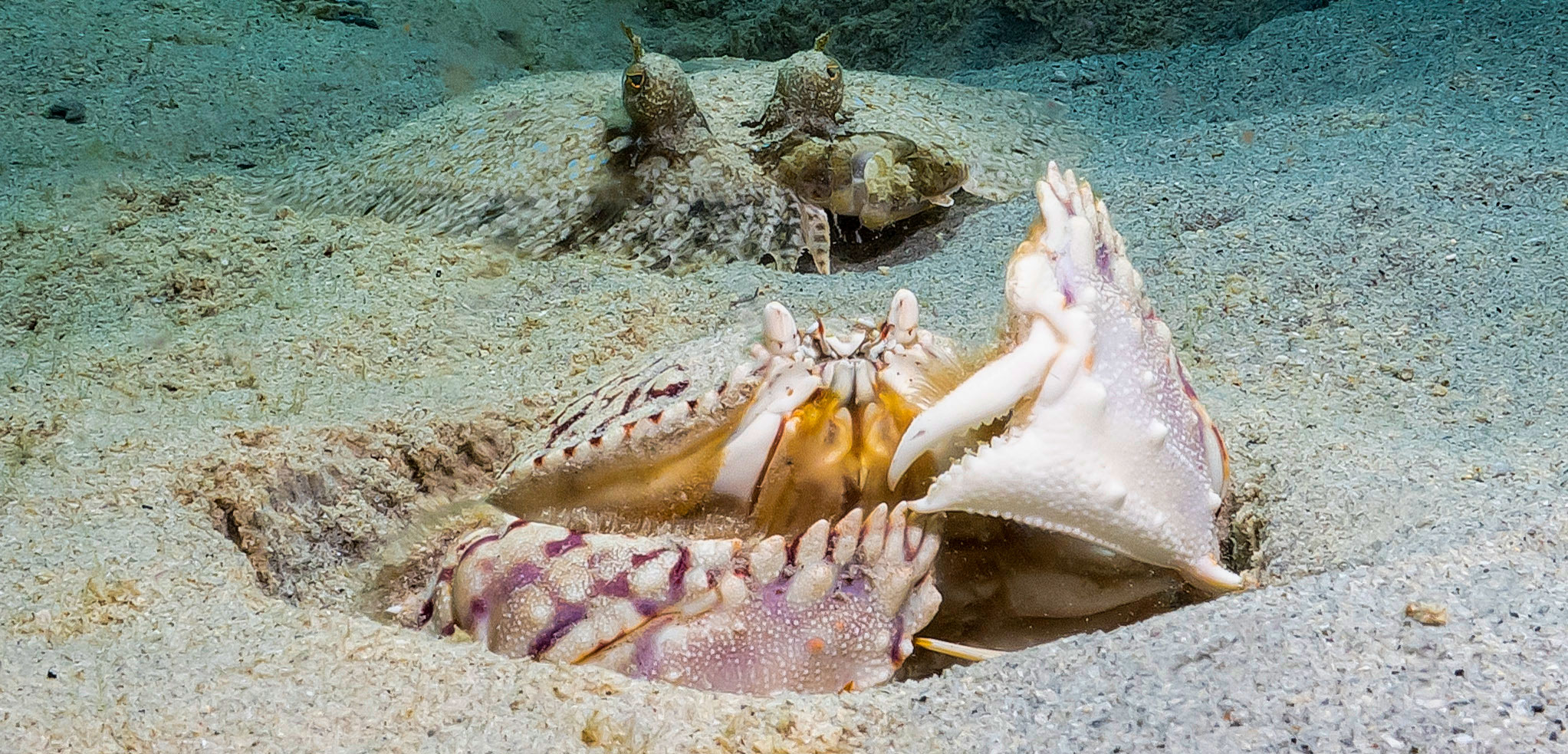Caribbean Box Crabs Have Stalkers
Aggressive fish follow crabs, forcing them to stir up food.
Article body copy
In shallow waters of the southern Caribbean, box crabs crawl along the sandy bottom, perhaps oblivious to the fact that they are being stalked by fish. But the fish aren’t particularly interested in the crabs themselves: they are chasing the small prey the crabs dislodge as they plough through the sand.
“The fish get a free meal because the crabs are moving the sediment, and all of these small invertebrates, like amphipods and little worms, just come flying out,” says Werner de Gier, a graduate student at the Naturalis Biodiversity Center in the Netherlands who witnessed these peculiar interactions while studying box crabs around the islands of Curaçao and Bonaire.
De Gier and his colleagues captured photos and videos of pearly razorfish and two different kinds of flounder stalking two species of box crabs. The footage showed that the flounder use a passive approach, following the crabs at a distance and snagging the food they kick up in their wake. When a crab stops and buries itself in the sand, the fish does the same. But razorfish are more active stalkers—they closely approach and circle a crab, snapping at it when it stops so that it continues walking.
Researchers discovered that flounder, such as the one here, are passive stalkers of box crabs, while razorfish are more aggressive. Video by Alev Ozten Low
Hiding in the sand helps crabs avoid predators, so De Gier thinks the interaction with razorfish, in particular, could be putting them at risk. They could get eaten because they’re not as fast as their predators, such as octopuses, says de Gier. “They’re really getting exposed.”
Scientists are aware of other feeding relationships between fish and crustaceans, though crustaceans typically play a secondary role. Cleaner shrimp, for example, pick the parasites and dead skin off fish. But it’s rare to find crustaceans playing a central role. Furthermore, while these kinds of interspecies interactions are common in rich ecosystems near coral reefs, they are much rarer in shallow, nearshore water where there is mostly sand and coral rubble, adds de Gier.
A similar kind of relationship—with fish stalking crabs—has been documented only once before, though it took place on the opposite side of the Atlantic, near the Canary Islands, and didn’t involve the same species.
But in the Caribbean, this kind of stalking seems to happen frequently. De Gier and his colleagues witnessed fish chasing half the crabs they observed. Though observations of it have been rare to date, de Gier believes that since box crabs are found in most tropical regions, this feeding interaction could be more widespread than previously thought.
De Gier hopes that follow-up experiments in a controlled environment could offer even more insight into this stalking behavior, such as how many razorfish might follow one crab, or if razorfish and flounder might pursue the same crab at the same time.
Topi Lehtonen, a behavioral ecologist at the University of Oulu in Finland who was not involved with the research, thinks that assessing how this stalking behavior affects the fitness of both the crabs and the fish could give more insight into why it occurs. “The researchers do not yet know how much the described behavior increases food intake by the fish,” Lehtonen says.
Iain McGaw, an ecophysiologist at Memorial University in Newfoundland and Labrador who also was not involved with the research, thinks it’s important to determine whether the interaction is fleeting or not. In his experience, dragging anything on the seabed is likely to attract fish looking for a quick meal. “The thing to find out,” he says, “is how faithful are these fish to their crab partners?
“Is it just an opportunistic interaction, or do they stay with the crabs long-term?”

